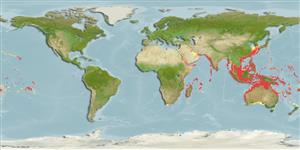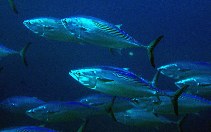添加你自己的观测位置在 Fish Watcher
| Native range | All suitable habitat | Point map | Year 2050 |

|
| This map was computer-generated and has not yet been reviewed. |
| Euthynnus affinis AquaMaps Data sources: GBIF OBIS |
Egypt country information
Common names:
[No common name]
Occurrence: native
Salinity: marine
Abundance: | Ref:
Importance: | Ref:
Aquaculture: | Ref:
Regulations: | Ref:
Uses: no uses
Comments:
National Checklist:
Country Information: https://www.cia.gov/library/publications/resources/the-world-factbook/geos/eg.html
National Fisheries Authority:
Occurrences: Occurrences Point map
Main Ref: Collette, B.B. and C.E. Nauen, 1983
National Database:
Occurrence: native
Salinity: marine
Abundance: | Ref:
Importance: | Ref:
Aquaculture: | Ref:
Regulations: | Ref:
Uses: no uses
Comments:
National Checklist:
Country Information: https://www.cia.gov/library/publications/resources/the-world-factbook/geos/eg.html
National Fisheries Authority:
Occurrences: Occurrences Point map
Main Ref: Collette, B.B. and C.E. Nauen, 1983
National Database:
Common names from other countries
分类 / Names 俗名 | 同种异名 | Catalog of Fishes(属, 种) | ITIS | CoL | WoRMS | Cloffa
Teleostei > Scombriformes (Mackerels) > Scombridae (Mackerels, tunas, bonitos) > Scombrinae
Etymology: Euthynnus: Greek, eu = good + Greek, thynnos = tunna (Ref. 45335).
Etymology: Euthynnus: Greek, eu = good + Greek, thynnos = tunna (Ref. 45335).
Environment: milieu / climate zone / depth range / distribution range 生态学
海洋; 海洋洄游的 (Ref. 51243); 深度上下限 0 - 200 m (Ref. 54439). 熱帶; 18°C - 29°C (Ref. 168); 35°N - 38°S, 19°E - 137°W (Ref. 54439)
分布 国家 | FAO区域 | 生态系 | 标本纪录 | Point map | 简介 | Faunafri
Indo-West Pacific: in warm waters including oceanic islands and archipelagos. A few stray specimens have been collected in the Eastern Central Pacific. Highly migratory.
印度-西太平洋: 在溫暖的水域包括大洋性島嶼與群島中。 一些迷途的標本曾經在中太平洋東部收集。 高度遷移的種,1982年海事法會議的附件一.(參考文獻 26139)
印度-西太平洋: 在溫暖的水域包括大洋性島嶼與群島中。 一些迷途的標本曾經在中太平洋東部收集。 高度遷移的種,1982年海事法會議的附件一.(參考文獻 26139)
Length at first maturity / 大小 / 重量 / 年龄
Maturity: Lm 42.3, range 40 - 65 cm
Max length : 100.0 cm FL 雄鱼/尚未辨别雌雄; (Ref. 168); common length : 60.0 cm FL 雄鱼/尚未辨别雌雄; (Ref. 168); 最大体重: 14.0 kg (Ref. 30874); 最大年龄: 6 年 (Ref. 121508)
Max length : 100.0 cm FL 雄鱼/尚未辨别雌雄; (Ref. 168); common length : 60.0 cm FL 雄鱼/尚未辨别雌雄; (Ref. 168); 最大体重: 14.0 kg (Ref. 30874); 最大年龄: 6 年 (Ref. 121508)
简单描述 检索表 | 型态特徵 | 形态测量图
背棘 (总数) : 10 - 15; 背的软条 (总数) : 11 - 15; 臀棘: 0; 臀鳍软条: 11 - 15; 脊椎骨: 39. This species is distinguished by the following characters: medium-sized fish with a robust, elongate and fusiform body; teeth small and conical, in a single series; total gill rakers on first gill arch 29-34; D1 XI-XIV with both dorsal fins separated by only a narrow interspace (not wider than eye), anterior spines of first fin much higher than those midway, giving fin a strongly concave outline; D2 much lower than first and followed by 8-10 finlets; anal fin followed by 6-8 finlets; pectoral fins short, never reaching interspace between dorsal fins; 2 flaps (interpelvic process) between pelvic fins; very slender caudal peduncle with a prominent lateral keel between 2 small keels at base of caudal fin; body naked except for corselet and lateral line. Colour of back dark blue with a complicated striped pattern which does not extend forward beyond middle of first dorsal fin; lower sides and belly silvery white; several characteristic dark spots between pelvic and pectoral fins (but may not always be present) (Ref. 9684, 90102).
泳鳔不存在。 椎骨突起的没有痕迹。 第一背鳍的前面棘比那些中间者高许多。 腹鳍间的突起小而两裂的。 身体裸露的除了甲胄与侧线。 背部的在后部部分具有一个断掉斜的斑纹的图案。
泳鳔不存在。 椎骨突起的没有痕迹。 第一背鳍的前面棘比那些中间者高许多。 腹鳍间的突起小而两裂的。 身体裸露的除了甲胄与侧线。 背部的在后部部分具有一个断掉斜的斑纹的图案。
Occurs in open waters but always remains close to the shoreline. The young may enter bays and harbors. Forms multi-species schools by size with other scombrid species comprising from 100 to over 5,000 individuals. A highly opportunistic predator feeding indiscriminately on small fishes, especially on clupeoids and atherinids; also on squids, crustaceans and zooplankton. Caught in multispecies fisheries, mainly by surface trolling; also with gill nets. Generally marketed canned and frozen; also utilized dried, salted, smoked and fresh (Ref. 9684).
出现于开放的水域但是总是逗留在接近海岸线。 幼鱼可能进入海湾与港湾。 形成多鱼种的依大小形成鱼群从 100 到超过 5,000个个体包含的与其它的鲭鱼种在一起。 不加选择地捕食小鱼的一个高度随机的掠食者, 尤其吃鲱鱼与银汉鱼; 也吃乌贼,甲壳动物与浮游动物.(参考文献 9684) 通常在市场上销售罐装及冷冻; 也利用乾燥的,盐腌的, 烟熏 (参考文献 9684) 与生鲜地.(参考文献 9987)
出现于开放的水域但是总是逗留在接近海岸线。 幼鱼可能进入海湾与港湾。 形成多鱼种的依大小形成鱼群从 100 到超过 5,000个个体包含的与其它的鲭鱼种在一起。 不加选择地捕食小鱼的一个高度随机的掠食者, 尤其吃鲱鱼与银汉鱼; 也吃乌贼,甲壳动物与浮游动物.(参考文献 9684) 通常在市场上销售罐装及冷冻; 也利用乾燥的,盐腌的, 烟熏 (参考文献 9684) 与生鲜地.(参考文献 9987)
Life cycle and mating behavior 成熟度 | 繁殖 | 产卵场 | 卵 | 孕卵数 | 仔鱼
印度-西太平洋: 在溫暖的水域包括大洋性島嶼與群島中。 一些迷途的標本曾經在中太平洋東部收集。 高度遷移的種,1982年海事法會議的附件一.(參考文獻 26139)
主要参考文献
Upload your references | 参考文献 | 合作者 : Collette, Bruce B. | 合作者
Collette, B.B. and C.E. Nauen, 1983. FAO Species Catalogue. Vol. 2. Scombrids of the world. An annotated and illustrated catalogue of tunas, mackerels, bonitos and related species known to date. Rome: FAO. FAO Fish. Synop. 125(2):137 p. (Ref. 168)
人类利用
渔业: 高经济性; 游钓鱼种: 是的
FAO(渔业: 产生, 物种外形; publication : search) | FIRMS (Stock assessments) | FishSource | 周边海洋
更多信息
Population dynamics
成长参数
Max. ages / sizes
Length-weight rel.
Length-length rel.
体长-频率
Mass conversion
入添量
丰度
成长参数
Max. ages / sizes
Length-weight rel.
Length-length rel.
体长-频率
Mass conversion
入添量
丰度
Physiology
Body composition
Nutrients
耗氧量
游泳类型
游泳速度
Visual pigments
Fish sound
Diseases & Parasites
Toxicity (LC50s)
Body composition
Nutrients
耗氧量
游泳类型
游泳速度
Visual pigments
Fish sound
Diseases & Parasites
Toxicity (LC50s)
Genetics
遗传学
Heterozygosity
遗传率
遗传学
Heterozygosity
遗传率
工具
Bio-Quiz | E-book | 野外调查 | 检索表 | 长度- 频率 Wizard | 生活- 历史的工具 | 分布图 | Classification Tree
| Catch-MSY |
特别资料
下载 XML
网络资源
Aquatic Commons | BHL | Cloffa | BOLDSystems | Websites from users | 核实 FishWatcher | CISTI | Catalog of Fishes(属, 种) | DiscoverLife | ECOTOX | Faunafri | Fishtrace | GenBank(基因组, 核苷酸) | GloBI | GOBASE | | Google Books | Google Scholar | Google | IGFA World Record | MitoFish | 国家资料库 | Otolith Atlas of Taiwan Fishes | PubMed | Reef Life Survey | 参考资料的核实 | Scirus | SeaLifeBase | 树状分类阶层 | Wikipedia(转至, 搜寻) | World Records Freshwater Fishing | 动物学的记录
Estimates based on models
Preferred temperature (Ref. 115969): 20.7 - 28.5, mean 26.9 (based on 1384 cells).
Phylogenetic diversity index (Ref. 82804): PD50 = 0.6250 [Uniqueness, from 0.5 = low to 2.0 = high].
Bayesian length-weight: a=0.01000 (0.00867 - 0.01154), b=3.05 (3.01 - 3.09), in cm Total Length, based on LWR estimates for this species (Ref. 93245).
营养阶层 (Ref. 69278): 4.5 ±0.0 se; based on diet studies.
回复力 (Ref. 120179): 中等的, 族群倍增时间最少 1.4 - 4.4年 (K=0.4-0.5; tm=3; Fec=210,000).
Prior r = 0.88, 95% CL = 0.58 - 1.32, Based on 5 full stock assessments.
Fishing Vulnerability (Ref. 59153): Moderate vulnerability (36 of 100).
Climate Vulnerability (Ref. 125649): High to very high vulnerability (75 of 100).




